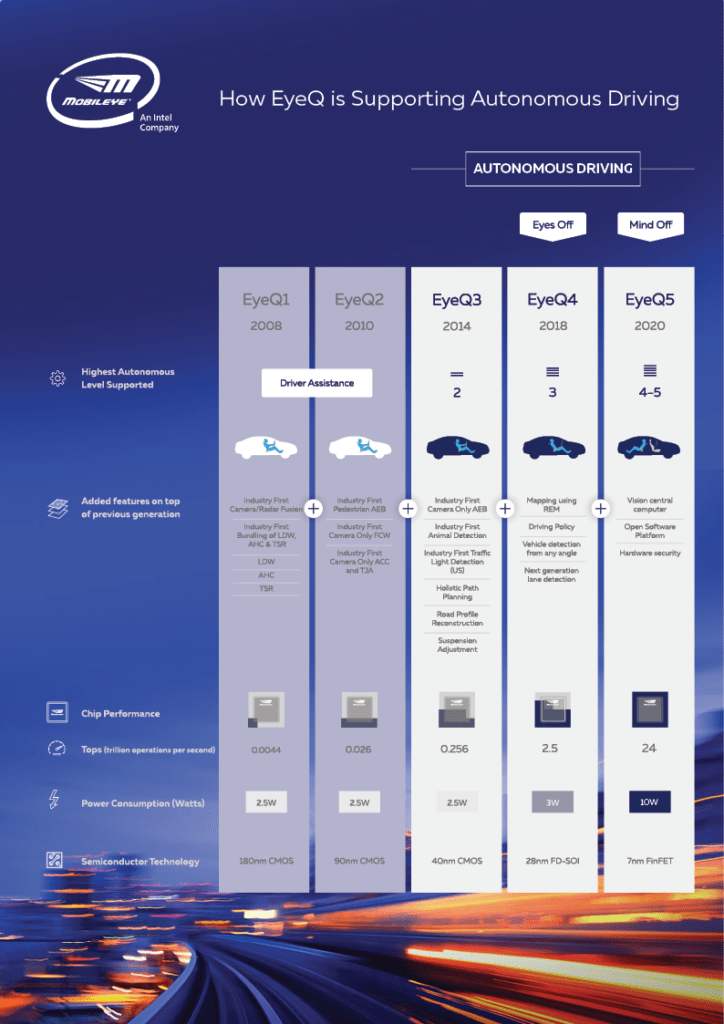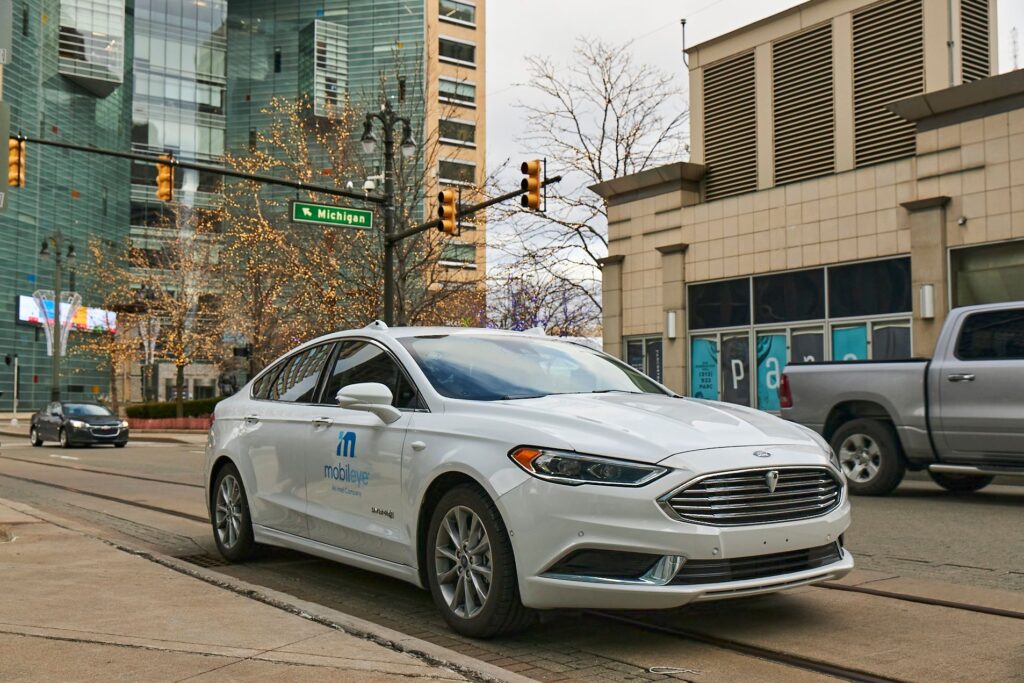Mobileye’s latest EyeQ soc will be able to support fully autonomous (Level 5) vehicles. Mobileye’s EyeQ® system-on-chip (SoC) devices have demonstrated their leadership in ADAS technologies.
Because of its capacity to support complicated and computationally intensive visual processing while maintaining low power consumption, more than 27 automobile manufacturers have chosen the EyeQ for their assisted-driving technologies.
The fifth-generation EyeQ from Mobileye is capable of supporting fully autonomous (Level 5) cars. Mobileye achieved the power-performance-cost targets by using patented computation cores (known as accelerators) that are designed for a wide range of computer vision, signal processing, and machine learning activities, including deep neural networks. These accelerator cores were created with the needs of the ADAS and autonomous driving sectors in mind. Each EyeQ chip has heterogeneous, completely configurable accelerators, each of which is optimized for a specific algorithm family. Because of the variety of accelerator architectures, programs can save both computing time and chip power by selecting the best core for each task. By optimizing task assignment to cores, the EyeQ is able to give “super-computer” capabilities while remaining inside a low-power envelope, allowing for cost-effective passive cooling.

Also Read:
Halo launches remotely operated car ride-hailing service using 5G technology.
-
AI-powered social innovations are poised to change the way we interact with urban environments – IBM
AI-powered social innovations are poised to change the way we interact with urban environments – IBM AI-powered social innovation to build more resilient cities. Technologies like Generative AI and AI Agents are poised to change the way we interact with urban environments and tackle economic and environmental challenges. Today, five new AI projects are ready…
[email-subscribers-form id=”1″]
The following are the fully programmable accelerator cores:
- The Vector Microcode Processors (VMP), first introduced in the EyeQ2, are now in their fourth iteration in the EyeQ5, and are designed in the most sophisticated VLSI process technology nodes – down to 7nm FinFET in the fifth generation. The VMP, a VLIW SIMD processor with cheap and flexible memory access, supports standard computer vision functions and is well-suited to multi-core scenarios. Its processing power is rated at 24 trillion operations per second, with a typical application requiring only 10 watts.
- The Multithreaded Processing Cluster (MPC) was first implemented in the EyeQ4 and is now in its second version in the EyeQ5. The MPC outperforms any GPU and is more efficient than any CPU.
- The Programmable Macro Array (PMA) was first launched in EyeQ4 and is now in its second version in EyeQ5. Without losing programmability, the PMA allows compute density to approach that of fixed-function hardware accelerators.
The EyeQ has generic multithread CPU cores in addition to Mobileye’s revolutionary and well-proven computer vision accelerators to provide the complete and robust computing platform that ADAS/AV applications demand.
STMicroelectronics (STM) and Mobileye have a long-standing partnership for the implementation of EyeQ devices. STM provides support in state-of-the-art physical implementation, as well as automotive-grade memory, high-speed interfaces, and system-in-package design, to ensure that the EyeQ devices pass the whole certification process according to the highest automotive requirements.
Mobileye has a track record of creating hardware to match the demands of each new level of autonomous driving, and we expect our computing capabilities to rise tremendously in the future. Indeed, each generation of the EyeQ has been around eight times more powerful than its predecessor in order to handle running increasingly higher numbers of different algorithms simultaneously while retaining the required low power dissipation.
ADAS, and especially high degrees of autonomous driving, necessitate a new level of functional safety concern. EyeQ devices are being developed for use in automobile systems that require the highest level of safety (i.e., ASIL D, according to the ISO 26262 standard).

Aside from the inherent safety requirements of an automobile application, security is also a consideration. The EyeQ5 was built with an integrated hardware security module that offers many new HW security capabilities to support the cyber-security requirements of ADAS/AV applications. System integrators may now provide safe over-the-air software updates, secure in-vehicle connectivity, and other features.
Automakers and Tier 1 suppliers receive EyeQ devices along with a comprehensive suite of hardware-accelerated algorithms and applications needed for ADAS and autonomous driving. Mobileye also offers an automotive-grade standard operating system and a complete software development kit (SDK) to let businesses differentiate their products by deploying their algorithms on EyeQ5. The SDK can also be used for neural network development and deployment, as well as access to Mobileye’s pre-trained network layers.
Architectural aspects like hardware virtualization and full cache coherency between CPUs and accelerators make EyeQ5 an open software platform easier to use. The processing of dozens of sensors, such as high-resolution cameras, radars, and LiDARs, is required for autonomous driving. The sensor-fusion process must simultaneously collect and process data from all sensors. EyeQ5 dedicated IOs support at least 40Gbps data bandwidth for this purpose. PCIe and Gigabit Ethernet ports with 18Gbps extra data bandwidth may be used to accommodate more sensors.
EyeQ5 has two PCIe Gen4 connections for inter-processor communication, which could allow for system expansion with multiple EyeQ5 devices or application processor connectivity. To handle high computational and data bandwidth needs, EyeQ devices use a high-performance network-on-chip interconnect and multi-channel low-power DDR interfaces.
About Mobileye:
Mobileye’s advanced driver assistance systems (ADAS) technology is deployed in more than 80 million vehicles today and is integrated into hundreds of new car models from the world’s major automakers including Audi, BMW, FCA, General Motors, Honda, Hyundai, Kia, Nissan, Volkswagen, and more. Mobileye began with the vision of reducing vehicle collisions and resulting injuries and fatalities. Today, Mobileye makes one of the most advanced collision avoidance systems on the market, while working toward autonomous driving and the coming autonomous mobility-as-a-service (MaaS) revolution in road safety.
Watch:
Mobileye brings driver-assistance tech to India for the first time in an Indian-made vehicle, together with their partners Mahindra & Mahindra.

